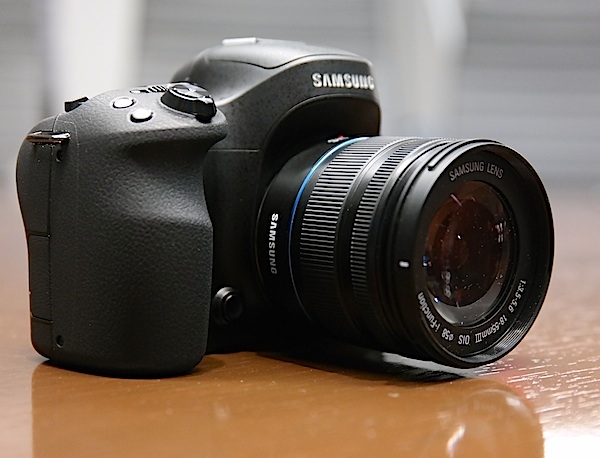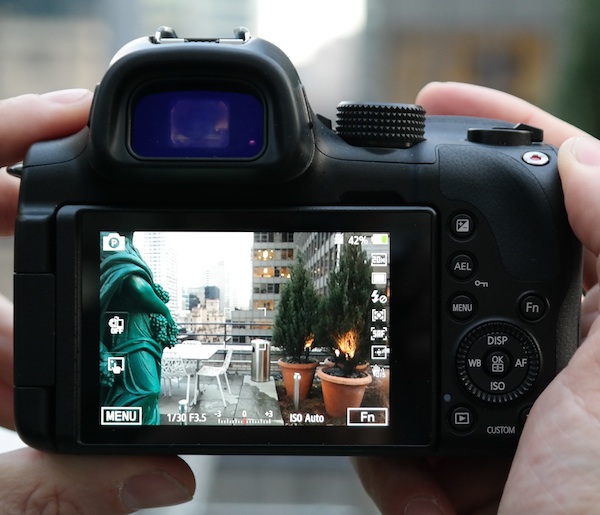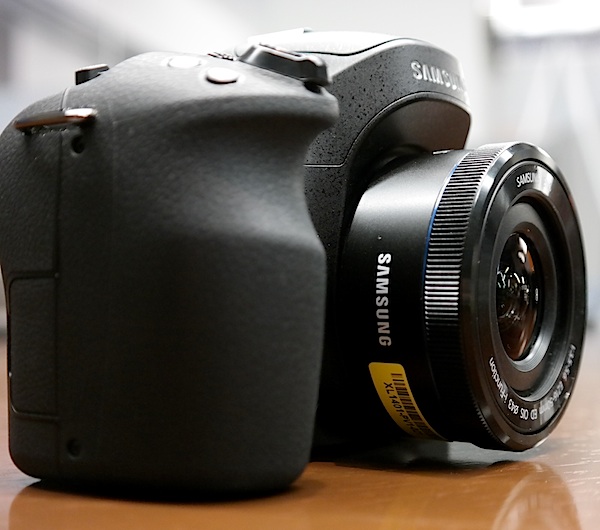Samsung NX30 Hands-On: Mirrorless Camera Challenges DSLRs
This update to Samsung's DSLR-like model includes better autofocus and low-light performance and a unique, tilting viewfinder.

Mirrorless cameras — essentially DSLRs without the optical viewfinder — continue to narrow the gap with traditional DSLRs. Samsung, which stopped making DSLRs in 2008, is nudging its mirrorless offerings a bit farther with its new NX30, introduced today (Jan. 2).
Tom's Guide had a chance to go hands on with a pre-production model of the 20.3-megapixel shooter, and we found several new features to like when comparing against its predecessor, the NX20, as well as Samsung's hugely popular NX300. Samsung hasn’t announced when the NX30 will go on sale or what it will cost; the NX20 currently sells for $550, with lens.
Better autofocus
Foremost is the new focusing system. For a long time, mirrorless cameras used the same, sluggish focusing tech found in point and shoots, a technology known as contrast detection. Using the image sensor itself, contrast detection requires the lens to keep hunting, back and forth, for the right position. All DSLRs, in comparison, have a special second focusing-sensor using a much faster method called phase detection.
MORE: DSLR vs. Mirrorless Cameras: Which Is Better for You?
Samsung was one of the first camera makers to incorporate phase detection into the camera's main image sensor. This first occurred on the company's popular NX300 camera, and now it comes to the higher-performance NX30. (Each camera has a whopping 105 phase-detection points, as well as 247 contrast points.) We found the focus on the pre-production NX30 to be about as fast as on the NX300 — which is to say, really fast. (Samsung claims 80 milliseconds, or eight thousandths of a second, to focus, which seems plausible.)
High-res, flexible optical viewfinder
Probably the biggest stumbling block for a DSLR fan is the lack of an optical viewfinder on mirrorless cameras. For most such cameras, if there is an eyepiece at all (in addition to a screen on the back), it has been a relatively low-res LCD with a painfully noticeable pixel grid. The NX30 takes the resolution up to 1024 x 768 — not a lot for a TV, but plenty for such a tiny screen (and a big improvement on the NX20's 800 x 600).

The NX30 viewfinder is bright, without noticeable pixels, providing a very good preview of a shot. It doesn't, however, have the lifelike color and detail of an OLED viewfinder, such as in Sony's pro-level A7 and A7r cameras, in which the view just as good as looking through the optical viewfinder of an SLR. (Of course, the A7 series cameras are considerably more expensive, starting at $1,700, without a lens.)
Sign up to get the BEST of Tom's Guide direct to your inbox.
Get instant access to breaking news, the hottest reviews, great deals and helpful tips.
One nifty trick for the NX30 viewfinder is the ability to pull it out about an inch and tilt it straight up, 90 degrees. In this configuration, you look down into the viewfinder while the camera stays pointing straight out — a first for any digital camera. Once we finished chuckling over the unmistakable sexual imagery of the viewfinder extending and then curving upward, we found the feature quite handy. It's great for holding the camera down low — for example, when shooting flowers or items on a table — without having to kneel on the floor. It also allows you to place the camera on a table or railing to stabilize it for a long-exposure night shot — without crouching down to get a preview.
The new viewfinder approximates the benefit of the tiltable screens on the back of cameras such as Samsung's NX300. The NX30 has an even more flexible screen, a 3-inch Super AMOLED that flips out to the left and can swivel 270 degrees for viewing with the camera held down low, up high or even facing you for a high-quality selfie. As on several other Samsung cameras, this OLED is also a capacitive touch screen, allowing you to access many adjustments and even set the focus point for a photo with just a tap. The screen should be about twice as bright as those on the NX20 and NX300 cameras, according to Samsung, though the company hasn't set an official brightness level yet.
Promise of better image quality
Perhaps Samsung's biggest promise for the NX30 is one we haven't yet been able to test — its low-light performance, specifically the ability to preserve more detail, with less graininess, when shooting at high light ISO (light sensitivity) settings. The camera we used did not have final software, and low-light performance can change considerably in the final tweaks before a camera ships out. (The NX30 goes up to a once-stratospheric, now increasingly common, ISO value of 25,600 — essentially night vision.)
MORE: Best DSLRs
But if the promise is true, that in itself would be a reason to get the NX30 over other Samsungs. The NX300, for example, though a generally great camera, disappoints at moderately high ISOs such as 1600, which you'll need for pretty much any indoor photography, without flash. (I used ISO 1600 and 3200 settings with an NX300 to shoot my nephew's basketball game and Christmas play, for example. Both were in fairly well-lit spaces, but they also required fast shutter speeds to avoid blur, thus the need for high ISOs to optimize the light.)

The current Samsung models don't produce grainy images at high ISOs, but they remove the graininess (known as noise) by smearing out a lot of detail, making the photos look a bit like paintings when you zoom all the way in. If the NX30 can retain even a bit more detail, it will make a huge difference when cropping into its photos.
Wireless everything
Like other Samsungs, the NX30 is tricked out for wireless capabilities. That includes transmitting data over both 2.4 GHz and 5GHz Wi-Fi frequencies — the latter allowing superfast uploads of images to a smartphone or laptop, as we've seen with other models. The NX30 can share images wirelessly to several nearby smartphones. And if a phone has an NFC (near-field communication) chip, all that's required to pair the devices is a tap. (Otherwise, it's a manual config process.)
Samsung has also updated its remote-control software to a version called Remote Viewfinder Pro. It allows an Android or iOS smartphone with Samsung's app to control nearly any aspect of the camera, including flash, shutter speed, aperture and zoom if the lens has a power zoom. (Some of Samsung's interchangeable lenses have power, in addition to manual zoom control.)
Overall experience of the NX30
From our early hands-on trial, the NX30 seems to be a very capable camera and a worthy rival to a DSLR in this price range. However, it may not feel much different from a DSLR. Unlike the sleek, minimalist designs of many mirrorless cameras, including Samsung's NX300, the NX30 really looks the part of a DSLR — dull black with a big handgrip.

Still it is a bit smaller than a comparable DSLR. And Samsung packs a lot of innovative features you won't find on most or any DSLRs, such as the articulating viewfinder, the superfast hybrid autofocus and the extensive wireless controls. Plus its lenses are compatible with Samsung's more stylish cameras such as the NX300. That makes for easy interchanges if you want to have serious and fun models (no DSLR is especially slim and stylish). And with the better electronic viewfinder, you aren't giving up much in terms of user experience.
Samsung will likely offer the option of buying the NX30 with the company's excellent 18-55mm zoom lens, with optical image stabilization (OIS), the standard lens included with the NX300. But several other lenses are available, too, including a new 16-50mm OIS lens that collapses to just 1.2 inches (31mm) long when the camera is off — about half the length of the standard kit lens.
NX30 key specs
Since it is a high-performance camera, specs will be important to many potential buyers. Here are the biggies:
- 20.3 MP, APS-C CMOS sensor
- 105 phase-detection and 247 contrast-detection focusing sensors
- Focus time: 80 milliseconds
- 5 frames per second
- Burst rate: 9 fps
- Electronic viewfinder (EVF): 2.36 mill dots, XGA resolution (1024x768), LCD
- Top shutter speed: 1/6000 sec. mechanical shutter, 1/8000 sec. electronic shutter
- ISO range: 100-25,600
- Video: Up to 1080p at 24fps, 30fps, 60fps
- Dual-band Wi-Fi (2.4GHz, 5GHz)
- 3.5mm microphone jack with line-in volume control
- Built-in flash: Guide 11 brightness
- Adobe Photoshop Lightroom 5 included (full version)
Follow Sean Captain @seancaptain and on Google+. Follow us @tomsguide, on Facebook and on Google+.
Sean Captain is a freelance technology and science writer, editor and photographer. At Tom's Guide, he has reviewed cameras, including most of Sony's Alpha A6000-series mirrorless cameras, as well as other photography-related content. He has also written for Fast Company, The New York Times, The Wall Street Journal, and Wired.
-
Steveymoo The problem with mirrorless cameras such as this one is, Samsung is trying to bolt too much unnecessary tech onto it to mark up the price. I like my DSLR, simply for the fact that everything feels so manual about it (viewfinder, changing settings etc.) It makes for a more satisfying outcome.Reply -
deborahjmurray my classmate's aunt makes $76 an hour on the internet. She has been unemployed for eight months but last month her check was $20677 just working on the internet for a few hours. check this =============> www.jobs39.comReply -
Vermil Please,.. "superfast hybrid autofokus"? No, nono, no, it's fast'ish. Under optimum conditions (strong light) and stationary object, it does 80 milliseconds, which spelled out is the same as one tenth of a second. That is not as much the problem as the wavering performance in demanding light, particularly with tele lenses, poor accuracy and poor prediction. Hybrid focus is an improvement, but there's no substitute for the large, multicrossed PD elements used by SLR and SLT cameras.Reply
"Probably the biggest stumbling block for a DSLR fan is the lack of an optical viewfinder " Umm, no. I sure like the lagless, direct contact and the real estimate of lighting differentials that an optical viewfinder offers, but the biggest stumblingblock of mirrorless cameras is their poor readiness, poor readiness comfort, poor battery performance, and poor battery comfort.
I have the highest regard and respect for Samsung's camera division. They do hi-Q stuff, they are serious. But the mirrorless systems with bigger sensors live in a sort of no-mans-land. There's no sensible use for them. They fail to be more compact, because the lenses remain the main bulk, and their weight and size is governed by the size of the sensor. They also fail to be more compact because, actually, they're not really. The truth is, they compromize their performance and capacity to shrink into a small house. And you can do that with an SLR too. Look at Canon 100D for instance.
Mirrorless excels as compact cameras with a limited lens, wide or normal, that are small enough that you can take them along always. Nex 5T and NX300 are good examples, but even better is going down in sensor size to m4/3, for an even smaller camera. Like Panasonic GM1 or Olympus PM2. A world apart in image quality from pocket cameras and mobile phone cameras.
But as system cameras, mirrorless is a redundant, castrated and expensive failure.
Cheap DSLRs from Nikon, Canon and Pentax offers so much more for less money.
